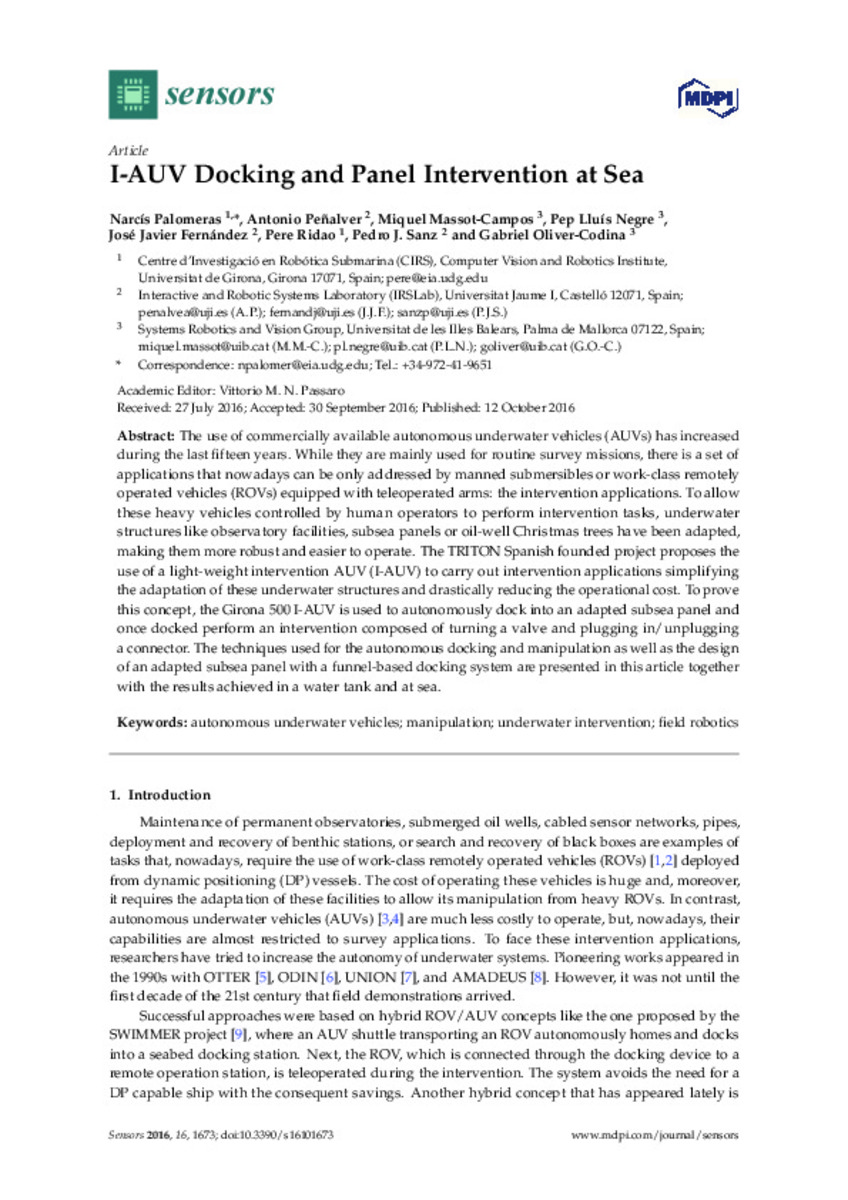Mostrar el registro sencillo del ítem
I-AUV Docking and Panel Intervention at Sea
| dc.contributor.author | Palomeras, Narcís | |
| dc.contributor.author | Peñalver Monfort, Antonio | |
| dc.contributor.author | Massot-Campos, Miquel | |
| dc.contributor.author | Lluís Negre, Pep | |
| dc.contributor.author | Fernández Fresneda, José Javier | |
| dc.contributor.author | Ridao, Pere | |
| dc.contributor.author | Sanz, Pedro J | |
| dc.contributor.author | Oliver-Codina, Gabriel | |
| dc.date.accessioned | 2016-12-02T15:12:01Z | |
| dc.date.available | 2016-12-02T15:12:01Z | |
| dc.date.issued | 2016 | |
| dc.identifier.citation | PALOMERAS, Narcís, et al. I-AUV Docking and Panel Intervention at Sea. Sensors, 2016, vol. 16, no 10, p. 1673. | ca_CA |
| dc.identifier.issn | 1424-8220 | |
| dc.identifier.uri | http://hdl.handle.net/10234/164896 | |
| dc.description.abstract | The use of commercially available autonomous underwater vehicles (AUVs) has increased during the last fifteen years. While they are mainly used for routine survey missions, there is a set of applications that nowadays can be only addressed by manned submersibles or work-class remotely operated vehicles (ROVs) equipped with teleoperated arms: the intervention applications. To allow these heavy vehicles controlled by human operators to perform intervention tasks, underwater structures like observatory facilities, subsea panels or oil-well Christmas trees have been adapted, making them more robust and easier to operate. The TRITON Spanish founded project proposes the use of a light-weight intervention AUV (I-AUV) to carry out intervention applications simplifying the adaptation of these underwater structures and drastically reducing the operational cost. To prove this concept, the Girona 500 I-AUV is used to autonomously dock into an adapted subsea panel and once docked perform an intervention composed of turning a valve and plugging in/unplugging a connector. The techniques used for the autonomous docking and manipulation as well as the design of an adapted subsea panel with a funnel-based docking system are presented in this article together with the results achieved in a water tank and at sea. | ca_CA |
| dc.description.sponsorShip | This work was supported by the Spanish project DPI2014-57746-C3 (MERBOTS Project) and by Generalitat Valenciana under Grant GVA-PROMETEO/2016/066. The University of Girona wants to thank the SARTI group for their collaboration with the TRITON project. | ca_CA |
| dc.format.extent | 18 p. | ca_CA |
| dc.format.mimetype | application/pdf | ca_CA |
| dc.language.iso | eng | ca_CA |
| dc.publisher | MDPI | ca_CA |
| dc.relation.isPartOf | Sensors, 2016, vol. 16, núm. 10 | ca_CA |
| dc.rights | 2016 by the authors; licensee MDPI, Basel, Switzerland. This article is an open access article distributed under the terms and conditions of the Creative Commons Attribution (CC-BY) license (http://creativecommons.org/licenses/by/4.0/). | ca_CA |
| dc.rights | Atribución 4.0 España | * |
| dc.rights.uri | http://creativecommons.org/licenses/by-sa/4.0/ | * |
| dc.subject | Autonomous underwater vehicles | ca_CA |
| dc.subject | Manipulation | ca_CA |
| dc.subject | Underwater intervention | ca_CA |
| dc.subject | Field robotics | ca_CA |
| dc.title | I-AUV Docking and Panel Intervention at Sea | ca_CA |
| dc.type | info:eu-repo/semantics/article | ca_CA |
| dc.identifier.doi | http://dx.doi.org/10.3390/s16101673 | |
| dc.rights.accessRights | info:eu-repo/semantics/openAccess | ca_CA |
| dc.relation.publisherVersion | http://www.mdpi.com/1424-8220/16/10/1673/html | ca_CA |
Ficheros en el ítem
Este ítem aparece en la(s) siguiente(s) colección(ones)
-
ICC_Articles [417]
Excepto si se señala otra cosa, la licencia del ítem se describe como: 2016 by the authors; licensee MDPI, Basel, Switzerland. This article is an open access
article distributed under the terms and conditions of the Creative Commons Attribution
(CC-BY) license (http://creativecommons.org/licenses/by/4.0/).








